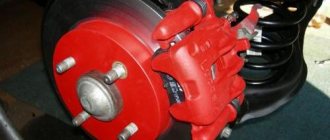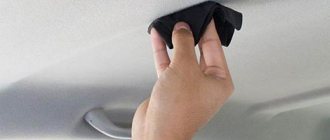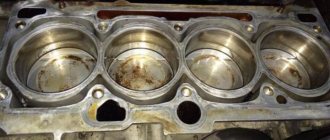If we ask an inexperienced driver what the car’s ground clearance is, we will definitely see bewilderment on his face. In fact, it is possible to understand beginners, because the word is unique if you don’t know it and its real meaning doesn’t come to mind. Moreover, many “experienced” people also learn about this term only when they think about increasing the clearance between the body and the ground, which is what ground clearance actually demonstrates.
Agree, such an idea lurks in the head of each of us, since all these holes, ditches, potholes and other damage to the road surface are already quite boring, and I just want to take it and “pull up my pants.” However, not everyone knows how to increase the ground clearance of a car, so they either postpone the undertaking until better times, or turn to a specialist, who, of course, needs to pay money. If you are thinking about the same thing right now, be reasonable and don’t rush! After all, no one forbids you to get acquainted with the possible options, and what if you manage to do everything in your own garage.
Why is this even necessary?
Imagine a perfectly flat bottom of the car, without any protruding parts.
Maybe in the future humanity will achieve such results, and we are Russians and will build our own roads, but today this is rather a fantasy. Therefore, ordinary drivers should not believe in miracles; they need to continue to maneuver deftly when traveling, trying not to damage the numerous units located at the base of the vehicle on the deformed asphalt road. I’ll tell you even more, there are often cases when even the body gets hit on such a “road,” so you need to use all available means to protect your own car, especially since you can do it yourself! How? Let’s dwell on this in more detail and look at the simplest methods.
Larger tires
I am sure that everyone is primarily interested in how to increase ground clearance with minimal financial costs. Therefore, let's start with the simplest and cheapest method - changing tires. Thus, you can easily win a couple of extra centimeters, but only if the design of your car allows you to increase the tire diameter without any consequences. In other words, the height of the inner wheel arch should be such that the tire does not touch the body when moving.
By turning a blind eye to this factor, the rubber will first erase the corrosion protection, and then the metal itself. If you can’t handle the iron, don’t worry, the moisture will finish the job. In addition, the tire itself will take on an excessively increased load, which will lead to its rapid wear.
What problems can increase the ground clearance cause to save the oil pan?
“I own a VW Passat B5. Very low ground clearance. Recently the pan broke, oil leaked, very expensive repair. They advised to raise it with spacers. What does installing spacers affect? Is it worth doing it at all? How else can you increase clearance?
When installing spacers to increase ground clearance, or, in other words, ground clearance, it must be taken into account that when the body is raised, the distance from the road surface to the center of gravity of the car simultaneously increases. As a result, the points of application of forces and moments from these forces acting on the car during movement change. The higher the center of gravity, the more rolly the car becomes when cornering, which reduces the threshold for safe cornering speed.
In addition to the deterioration in controllability after increasing the ground clearance, the car begins to nose-dive more when braking, and during sharp emergency braking, due to the redistribution of masses forward during the dive, depending on how slippery the surface turns out to be, the rear wheels may completely lose traction. , which often ends with the car skidding.
It is possible that due to the redistribution of loads, changes in geometry and suspension travel, you will have to pay for an increase in ground clearance by reducing the reliability and service life of individual parts of the chassis. At least that's what the theory goes.
Finally, in addition to deteriorating safety, an excessive increase in ground clearance affects the aesthetic perception of the car. A car with an excessively raised body above the road, if it is not specially prepared for off-road competitions, but participates in regular road traffic, looks, to put it mildly, controversial.
According to experts, for passenger cars the point beyond which raising the body will cause more harm than good is an increase in ground clearance by more than 4-5 cm.
The use of spacers has been known since the times of the Soviet Union, when sets of factory-made parts for mass-produced car models, which needed to be installed between the suspension springs and the body, could be bought at car stores.
Factory kits with spacers, including those with adjustable ride height, for various car models still exist, but now you have to look for them.
In addition to spacers, there are other ways to increase ground clearance. The above photos give an idea of some of them. Since any of the methods increases the height of the car’s center of gravity, they have the same disadvantages as lifting the body using spacers. We recommend that you read our article from 7 years ago, “Higher, and higher, and higher.” It may turn out to be interesting, since in addition to considering the advantages and disadvantages of these methods, the owner of an Audi A6 2000 shares his experience of doubling the ground clearance. with a suspension structurally similar to that of the Passat B5.
And one last thing. The question of increasing ground clearance using spacers by default assumes that the ground clearance is the rated one. And it may turn out to be lower than the nameplate value due to the car being equipped with a factory sports suspension or as a result of tuning carried out by the previous owner. In this case, the ground clearance can be increased without resorting to spacers by installing parts from the standard suspension. Ground clearance also decreases if the suspension springs sag or their outer coils are broken, which sometimes inexperienced owners don’t even realize. To bring the vehicle's cross-country ability back to normal, it is enough to replace the springs with new ones.
Springs of various stiffnesses are available for sale. It should be borne in mind that springs that are too soft improve ride comfort, but can also create problems when overcoming road obstacles.
Finally, you should make sure that the wheel size matches that specified by the car manufacturer. It could have been changed because, according to some owners, a car with low-profile tires looks more beautiful, but its installation could also negatively affect the ground clearance. The opposite is also possible: installing tires and wheels of a different size allows you to slightly increase ground clearance. However, this raises issues with wheels flying out, touching the arches when turning, and incorrect speedometer readings.
Sergey BOYARSKIKH Photos by the author and from open sources ABW.BY
You have questions? We have the answers. Topics that interest you will be expertly commented on by either specialists or our authors - you will see the results on the website abw.by. Leave questions on the forum or use the “Write to the Editor” button
Larger rims
A similar effect can be achieved by increasing the diameter of the disks. A set of light alloy products will definitely cost a pretty penny, so there is no need to talk about savings here. As with a tire, when choosing a rim you need to take into account a number of nuances:
- Wheel arch height;
- Hub diameter;
- Location of mounting bolts.
Having found and installed a suitable model, minor bumps when driving will become less noticeable, and the car as a whole will begin to look much more aggressive. By the way, by combining the two methods described above, it will be possible to achieve a maximum increase in ground clearance, but not every car will allow you to perform such a procedure. Maybe SUVs with their 20-centimeter distance to the ground.
The process of installing a spacer to increase ground clearance
To ensure that the process of installing spacers under the spring with your own hands does not cause difficulties, you should pay attention to the following recommendations:
Spacer installation diagram
- To prevent rust, metal parts should be treated with anti-corrosion agents.
- A front-wheel drive vehicle must not be raised more than 20 mm.
- The best result can be achieved if you install spare parts on both sides of the spring.
- To know exactly the location of the bolts, you need to watch video materials or a schematic image in advance.
- When tuning the rear of the vehicle, it is necessary to take into account the angle of the resulting inclination.
- If you go too far with the ride height, there is a high probability of problems with wheel alignment.
- In order to install the part, special bolts and studs are required.
Front installation
There is a sequence of steps to install spacers to increase ground clearance with your own hands in front of the car:
Front and rear spacers
- You need to put the front of the vehicle on a jack and remove the wheel.
- After this, you need to disconnect the braking system and unscrew the nuts from the rack, having previously tightened the springs with a tie.
- Next, you need to unscrew the nuts from the upper support and completely remove the front stabilizer link.
- The old bolts need to be replaced with new ones that are longer.
- Afterwards you need to install the spacer and assemble the parts in the reverse order.
A similar algorithm must be applied to the second wheel.
Rear installation
The instructions for installing spacers at the rear of the car are slightly different from those described above:
Installing a spacer
- First you need to remove the sills under the trunk lid and from the rear doors of the car.
- For convenience, you need to move the rear seats forward all the way and remove the trim from the loading compartment and sides to open access to the body.
- After this, you need to jack up the rear of the car and remove the wheel.
- Then the nuts are unscrewed and the support is removed.
- The old bolts, as in the first case, are replaced with parts of longer length.
- After all these steps, you need to install the spacer and assemble all the parts in the reverse order.
Related video: Do-it-yourself spacers for increasing ground clearance
Publications on the topic
How to make a trailer for a walk-behind tractor with your own hands
Self-installation of xenon
Self-installation of an alarm system with automatic start
Replacing springs
The shock-absorbing spring is a key component of the vehicle that has a direct impact on the height of the vehicle as a whole. Not a single tuning of the “iron horse” is complete without replacing them; sports cars are all on rigid suspension. Of course, to complete the operation completely, you will have to work hard.
To change the design of the car (and there is no other way to call it), you need to disassemble both the front and rear suspensions. After which, you can select new springs, which must be the same diameter as the old ones. With rigidity, everything is quite the opposite; its indicator should be higher than that of the dismantled product (see the marking).
Many craftsmen even manage to install springs with an additional link, and then complain that the interior feels like a coward in a tractor. Therefore, when replacing springs, remember - the higher their stiffness, the lower the level of comfort. The final price of such repairs will be increased by shock absorbers, which will also need to be replaced for the benefit of your suspension.
How to avoid mistakes when installing spacers
When installing spacers to increase ground clearance, the following rules must be observed:
- Do not install the part if the body has not been treated with anti-corrosion treatment.
- Do not raise the front of front-wheel drive vehicles by more than 2 cm.
- Before installing the gasket, you need to make sure that the kit contains all the studs and bolts of the required sizes.
- For cars in which the springs are not located near the shock absorber strut, special spacers are also mounted under the shock absorbers. This will ensure they have a long service life and the entire suspension will be synchronized.
- After installing the gaskets, you need to make sure that the car body does not exceed the level of inclination necessary for normal movement (the body should not be raised higher than 3 cm). Such an excess will not allow for normal wheel camber and will lead to uneven tire wear.
Gasket backing
Rubber or polymer gaskets (pictured) are another option for increasing the vehicle's ground clearance. They can be found in any auto store, where they will even explain to you where to install them. Here I will take on this responsibility. There is nothing complicated, you need to install a gasket between the shock absorber support strut and the car body. In addition, the cost of increasing ground clearance using spacers is even less than simply replacing tires.
But, like everywhere else, it has its downsides. Not only will the high wear of the gasket force you to change them at least once a year, but the center of gravity will also change, and this will slow down the car’s response to steering column signals, and will also change the braking torque.
Probably every owner of a small hatchback dreams of an additional 2-5 cm of ground clearance. Today, you learned simple, but no less valuable information on how to increase clearance. However, the suspension of modern cars is somewhat different from the good old VAZ, so in conclusion I am attaching a video especially for owners of classics. I'm done with this, all the best!
What is better – cars with variable clearance or increased clearance?
Overcoming an obstacle by forcing the car to literally tiptoe, albeit at the expense of a significant reduction in speed - isn’t this the dream of every driver? However, vehicles that have components to increase ground clearance at will are somewhat more expensive than models that are not equipped with such a function. And only a few can afford cars with variable ground clearance. But how convenient: the speed is reduced to 20 kilometers per hour, the toggle switch is pressed, fluid is pumped into a special cushion between the body and the shock absorber using hydraulics, and the clearance increases. When the speed increases, the car itself sags to its previous position.
But what about those who do not have such a system? It is possible to raise the body artificially, however, this is not always safe. In particular, intercoil attachments can be installed in the suspension springs, as a result of which the elastic elements will compress less under the weight of the body, but be prepared for an increase in motion rigidity. Installing more powerful springs reduces the rebound stroke of the shock absorbers, and at the same time makes these units fail faster. Car enthusiasts sometimes install aluminum attachments between the body and the pillar support, but there is also a drawback here - such elements provoke corrosion with the salt mixture that is used to treat icy roads. The best option is to install rubber attachments instead of aluminum ones.











